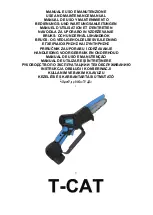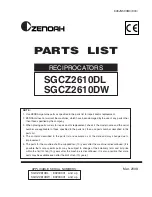
OPERATION
15
• Check the dust bag before you work. Empty the bag if it is
more than half-full.
RECOMMENDED ACCESSORIES
• Consult the ACCESSORIES and ATTACHMENTS section of
this Operator’s Manual for recommended accessories. Follow
the instructions that come with the accessory. The use of
improper accessories may cause risk of injury to persons.
• Choose the correct 10 in. diameter blade for the material
and the type of cutting you plan to do. Do not use thin kerf
blades.
• Make sure the blade is sharp, undamaged and properly
aligned. With the saw unplugged, push the cutting arm all the
way down. Manually spin the blade and check for clearance.
Tilt the power-head to a 45° bevel and repeat the test.
• Make sure the blade and arbor collars are clean.
• Make sure all clamps and locks are tight and there is no
excessive play in any parts.
KEEP YOUR WORK AREA CLEAN
Cluttered areas and benches invite accidents.
WARNING
To avoid burns or other fire damage, never
use the miter saw near flammable liquids, vapors, or
gases.
• Plan ahead to protect your eyes, hands, face and ears.
• Know your miter saw. Read and understand this Operator’s
Manual and labels affixed to this tool. Learn its application
and limitations as well as the specific potential hazards
peculiar to this tool. To avoid injury from accidental contact
with moving parts, do not do layout, assembly, or setup
work on the miter saw while any parts are moving.
• Avoid accidental starting, make sure the trigger switch is
disengaged before plugging the miter saw into a power outlet.
PLAN YOUR WORK
• Use the right tool. Don’t force a tool or attachment to do a
job it was not designed to do. Use a different tool for any
workpiece that can’t be held in a solidly braced, fixed position.
CAUTION
This machine is not designed for cutting
masonry, masonry-like products, ferrous metals (steel,
iron, and iron-based metals.) Use this miter saw to cut
only wood, woodlike products, or non-ferrous metals.
Other material may shatter, bind the blade, or create
other dangers. Remove all nails that may be in the
workpiece to prevent sparking that could cause a fire.
Remove dust bag when cutting non-ferrous metals.
DRESS FOR SAFETY
Any power tool can throw foreign objects into the
eyes. This can result in permanent eye damage.
Everyday eyeglasses have only impact resistant
lenses and are not safety glasses. Glasses or
goggles not in compliance with ANSI Z87.1 could
seriously injure you when they break.
• Do not wear loose clothing, gloves, neckties or jewelry
(rings, watches). They can get caught and draw you into
moving parts.
• Wear non-slip footwear.
• Tie back long hair.
• Roll long sleeves above the elbow.
USE EXTRA CAUTION WITH LARGE OR ODD SHAPED
WORKPIECES.
• Use extra supports (tables, sawhorses, blocks, etc.) for
workpieces large enough to tip.
• Never use another person as a substitute for a table
extension, or as an additional support for a workpiece that
is longer or wider than the basic miter saw table, or to help
feed, support, or pull the workpiece.
• Do not use this saw to cut small pieces. If the workpiece
being cut would cause your hand or fingers to be within
6-3/4 inches of the saw blade the workpiece is too small.
Keep hands and fingers out of the “no-hands zone” area
marked on the saw table.
• When cutting odd shaped workpieces, plan your work so it
will not bind in the blade and cause possible injury.
Molding, for example, must lie flat or be held by a fixture
or jig that will not let it move when cut.
• Properly support round material such as dowel rods, or
tubing, which have a tendency to roll when cut, causing
the blade to “bite”.
• Noise levels vary widely. To avoid possible hearing
damage, wear ear plugs when using any miter saw.
• For dusty operations, wear a dust mask along with safety
goggles.
INSPECT YOUR WORKPIECE
Make sure there are no nails or foreign objects in the part of
the workpiece being cut. Plan your work to avoid small pieces
that may bind, or that are too small to clamp and get a solid
grasp on.
Plan the way you will grasp the workpiece from start to finish.
Avoid awkward operations and hand positions. A sudden slip
could cause your fingers or hand to move into the blade.
DO NOT OVER-REACH
Keep good footing and balance. Keep your face and body to
one side, out of the line of a possible kickback. NEVER stand
in the line of the blade.
Never cut freehand:
• Brace your workpiece firmly against the fence and table
stop so it will not rock or twist during the cut.
• Make sure there is no debris between the workpiece and
the table or fence.
• Make sure there are no gaps between the workpiece, fence
and table that will let the workpiece shift after it is cut.
• Keep the cut off piece free to move sideways after it is cut
off. Otherwise, it could get wedged against the blade and
thrown violently.
• Only the workpiece should be on the saw table.
• Secure work. Use clamps or a vise to help hold the work
when it’s practical.
WARNING
To avoid injury, follow all applicable safety
instructions, when cutting non-ferrous metals:
• Use only saw blades specifically recommended for
non-ferrous metal cutting.
• Do not cut metal workpieces that must be hand held. Clamp
workpieces securely.
• Cut non-ferrous metals only if you are under the
supervision of an experienced person and the dust bag has
been removed from the saw.
Summary of Contents for KN M-2508RC
Page 52: ...www knova com mx...
















































